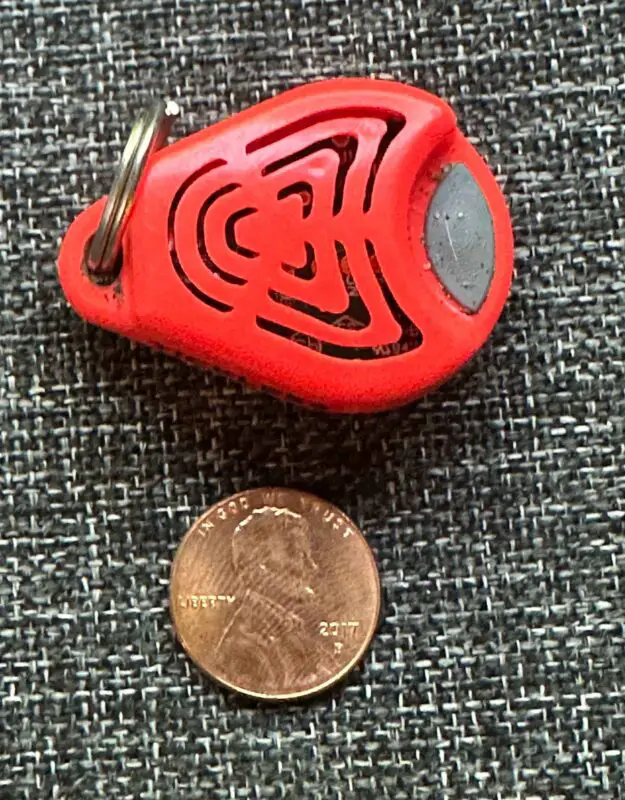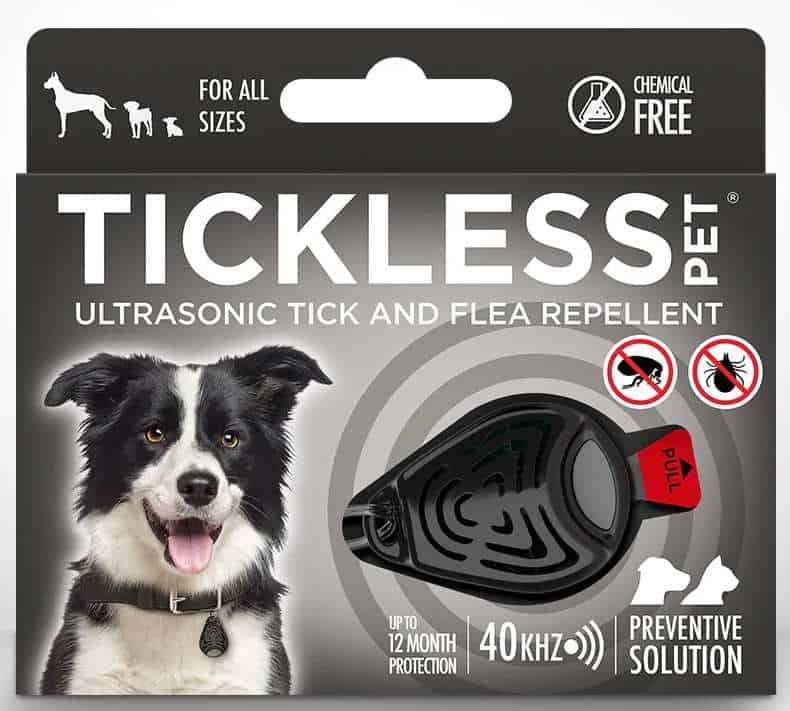The Science Behind
Ultrasonic Flea and Tick Repellents
Many dog parents are insisting on chemical-free protection against fleas and ticks, due to potential adverse effects related to conventional pesticides. The balance of research supports ultrasonic flea and tick repellants as 94% effective and a safe part of chemical-free protection, when used with essential oils and an immune-boosting diet.
Chemical-Free Protection Against Fleas and Ticks
If you’re looking for an effective, chemical-free way to prevent fleas and ticks from biting your dog, you may have heard about ultrasonic repellants, like Tickless brand.
At Healing Fur Souls, our holistic pet experts stopped using oral and topical chemical pesticides after our dog suffered an adverse reaction.
We switched to homemade essential oil sprays and an immune-boosting diet which were effective, but we continued to look for chemical-free ways to boost our dogs’ protection even more. We were impressed with our experience with Tickless ultrasonic flea and tick repellants, and have added it to our Holistic Flea and Tick Prevention Program.
In this article, we do a deep dive into the research behind Tickless ultrasonic technology. To learn about our personal experience with Tickless and why we recommend it, read our comprehensive review.
How Do Ultrasonic Flea and Tick Repellents Work?
Small devices worn near the dog emit high frequency sound waves that pulse over a range of about 5 feet (1.5 m). The 40 kHz ultrasonic waves are imperceptible to humans and most pets, but affect pests by interfering with their ability to orient themselves. A disoriented flea or tick has difficulty attaching to or biting a pet, rendering them harmless.
Ultrasonic Flea and Tick Repellents: A Look at the Research
At Healing Fur Souls, we love to get our nerd on! In this article, we take a deep dive into the science of ultrasonic technology for flea and tick prevention. We look at the top studies to explore how ultrasonic flea and tick repellents like Tickless work, and how effective and safe they really are for dogs.
The best kinds of evidence for pet parents includes research and experience, so we also share our personal experience with Tickless ultrasonic flea and tick prevention. Read our hands-on review and experience with Tickless after using it for three seasons.
Are ultrasonic flea and tick repellants effective and safe for dogs? Here’s our take on the science behind the technology.
Early Use of Ultrasound Technology
Ultrasonic technology was introduced to medicine in the early 1900’s and is commonly used now to visualize soft tissue, internal organs and pregnancies, and in remote control devices and parking sensors. Ultrasound technology was patented for use as a pest repellent in 1985.
Tickless Italian Study
Tickless’ ultrasonic technology underwent testing in a clinical study at the School of Veterinary Medical Microbiology and Infectious Diseases Laboratory at the University of Camerino, Italy (2016).
The study’s author Cuteri, conducted a small blind study with 45 shelter dogs that had a high, constant exposure to ticks. The study compared the ultrasound technology with traditional spot-on flea and tick chemicals.
Cuteri determined that the ultrasound technology:
- was effective against several species of ticks and fleas
- prevented initial attachments in dogs that already had fleas or ticks
- prevented further attachments in all dogs
- after 30 days, 100% of the dogs either had no additional ticks or the number of ticks decreased significantly
- was not linked with any hearing disturbances in dogs
- is recommended to be used in conjunction with other flea and tick solutions.
Tickless American Study
An American study (2018) explored whether Tickless was as effective in the USA as it was in Europe. One hundred dog parents in the southern USA were surveyed after 60 days of using Tickless on their dogs.
This study found that:
- 94% of pets remained completely tick-free
- 88% stayed flea-free during the test period
- 6% of owners believed their pet had fewer ticks than usual
- 12% found fewer fleas than usual
- no side effects (including hearing disturbances) were reported
The Thai Study of Ultrasonic Devices
We were interested in a recent (2021) study from Thailand that tested 9 Ultrasonic Flea and Tick devices, including 2 Tickless devices (one for pets; one for horses). It measured the number of Australian ticks that actively moved away from each device by moving through an insect “escape chamber”.
Only four of the ultrasonic devices the authors used claimed to repel ticks (as opposed to other insects), but were included in the study anyway. The authors found that:
- All 9 devices repelled some ticks (about 20% actively escaped the test area), although the results were not statistically significant
- Several additional ticks were scattered about the test area and appeared sluggish or disabled, possibly indicating disorientation. In the real world, these disoriented insects would be less likely to attach to and bite a pet. However these ticks were not counted or included in the results.
Although the authors were not able to prove that the ultrasonic devices significantly repelled the Australian tick, they acknowledged that several ticks escaped or appeared disabled and unable to latch or bite. If those had been counted in the results, we may have seen a more encouraging conclusion that more closely reflects the Italian and US studies.
The South African Study of Ultrasound Devices
An early South African study (1991) tested a 35 kHz ultrasound device (not Tickless) by deploying it in a box of insects. The authors found that it didn’t significantly affect the distribution of fleas in the chamber and concluded that the device was ineffective. Recent studies test devices with higher frequencies and add to a growing body of evidence.
Differing results reminds us that research and technology are evolving, and results need to be reviewed with a view to context, bias, relevancy and personal experience.
Critics of Ultrasonic Flea and Tick Repellents
Our holistic pet experts have combed through the research and used ultrasonic devices with our dogs for years. In our experience, they have become an important part of our Holistic Flea and Tick Prevention Program, but ultimately we want you to make your own decisions. It’s important to listen to all research and experiences – including dissenting opinions. Here are some things to keep in mind as you do your own research.
Sound versus Disorientation
Critics of ultrasound technology cite studies that suggest fleas and ticks cannot hear the frequencies emitted by ultrasound pest repellent devices. While the insects may not “hear” the frequencies, they really don’t need to – the ultrasonic frequencies aim to disorient the pest so that they don’t attach (or they fall off your dog), not blast them with volume. Remember, ultrasounds (like those used in pregnancy) work very effectively without emitting any audible noise.
Preventing versus Killing Fleas
Critics note that some ultrasonic devices don’t kill or affect the behavior of fleas that are already attached to dogs. Tickless is clear that their devices are aimed at preventing fleas (and ticks), although the Italian study has shown that the device may also reduce the attachment (biting) of fleas that were already present on a dog.
Whether insects die off or fall off, the bottom line is to keep them off your dog. The Thai study measured ticks that ran away from the devices, but also noted several unmoving and disabled ticks. Those disabled ticks were not considered to have been affected by the ultrasonic technology, yet were unable to latch or bite. In the real world, this is exactly the result we want.
Studies: Cats versus Dogs
Many early studies that don’t support ultrasonic repellants were performed with cats – not dogs. Although we may be told that shouldn’t make a difference, it’s not ideal to extrapolate findings from cats to dogs. Cats and dogs may differ in their grooming habits, diet, pH of skin and blood, movements, fur condition or other variables.
Early Studies versus Recent Research
Research is always evolving, and we can only base our treatment decisions on the most recent, robust studies (plus personal experience). Many studies criticizing ultrasonic technology were published in the early 1980s and 1990s, when the technology was not refined or well established. These studies often used “brandless” devices or those that were intended as household units.
Industry Funding
Ethical academics are highly aware that studies funded by industry, manufacturers or special interest groups may be biased. Beware of this and review research with an eye to identifying possible bias. Studies that have passed through an Ethics Review Board, are independently funded and peer reviewed are preferred to industry-funded research or special interest groups.

The Bottom Line: Should I Use Ultrasonic Flea and Tick Repellents?
When deciding whether an ultrasonic flea and tick repellent device is right for your dog, consider these questions:
![]() Is my dog pregnant, young (puppy), senior, sensitive to toxins, over-vaccinated or have any health concerns? You may wish to reduce the toxic load of conventional flea and tick pesticides by trying an ultrasonic device.
Is my dog pregnant, young (puppy), senior, sensitive to toxins, over-vaccinated or have any health concerns? You may wish to reduce the toxic load of conventional flea and tick pesticides by trying an ultrasonic device.
![]() Am I willing to provide my dog with a healthy, whole foods diet to boost her natural immune system? Chemical-free solutions may not provide 100% protection on their own, but can be very effective when more than one are used together.
Am I willing to provide my dog with a healthy, whole foods diet to boost her natural immune system? Chemical-free solutions may not provide 100% protection on their own, but can be very effective when more than one are used together.
![]() Am I willing to use essential oils, herbs or homeopaths to increase my dog’s protection against fleas, ticks and associated diseases? Essential oils are well researched for their pest-repelling qualities. Herbs can support natural immunity and homeopaths can prevent bacteria and parasites from developing into disease.
Am I willing to use essential oils, herbs or homeopaths to increase my dog’s protection against fleas, ticks and associated diseases? Essential oils are well researched for their pest-repelling qualities. Herbs can support natural immunity and homeopaths can prevent bacteria and parasites from developing into disease.
In light of the research and our experiencing using Tickless ultrasonic flea and tick repellents for three years, we recommend using Tickless as part of a chemical-free Holistic Flea and Tick Prevention Program including:
![]() Homemade essential oil sprays. Our recipes use pest-repelling oils like turmeric, lavender and cedar and are easy to make.
Homemade essential oil sprays. Our recipes use pest-repelling oils like turmeric, lavender and cedar and are easy to make.
![]() An immune-boosting diet. Insects don’t like healthy hosts. We use a grain-free, raw diet with plenty of vegetables, healthy oils, probiotics and garlic.
An immune-boosting diet. Insects don’t like healthy hosts. We use a grain-free, raw diet with plenty of vegetables, healthy oils, probiotics and garlic.
![]() Herbs and homeopaths as needed to support immunity and treat insect bites
Herbs and homeopaths as needed to support immunity and treat insect bites
If you want to learn more about ultrasonic technology, read on.
Ultrasonic Flea and Tick Technology: The Nitty Gritty Details
What is an Ultrasonic Wave?
An ultrasonic wave is simply sound energy at frequencies higher than 20,000 Hz (20 kHz). Because ultrasound frequencies are short waves, they cannot travel far (less than 6.2 feet or 1.9 m) and are quickly absorbed in the air.
Animals Use Ultrasound
Bats and porpoises use ultrasound (between 100-200 kHz) to locate prey and avoid obstacles. Insects are known to avoid the frequencies of bats that emit ultrasound frequencies, which is likely where the concept of ultrasonic repellants originated.
Medical Use of Ultrasound
Human and veterinary medicine use ultrasound technology to visualize soft tissue and internal organs. This technology is also used to visualize pregnancies, in medical aesthetic procedures, teeth cleaning, underwater communications, remote control devices and parking sensors.
What is the Frequency of Tickless Ultrasonic Repellants?
Research suggests that frequencies between 35-45 kHz are the most effective for repelling pests like fleas and ticks. The Tickless ultrasonic device emits ultrasonic pulses at 40 kHz. This frequency is believed to interfere with the ability of parasites to orient themselves, thus preventing them from latching or biting your pet within 5 feet of the device.
Can Dogs Hear Ultrasonic Frequencies?
Most humans cannot hear sound frequencies above 20,000 Hz (20 kHz), but dogs have been known to hear up to 45 kHz, making it possible for highly sensitive dogs to perceive Tickless’ frequency of 40 kHz. There is no evidence to suggest dogs are bothered by these short wave frequencies, as the volume is extremely low (20.8 decibels). When we activated the Tickless device, our dog alerted for a few seconds, then ignored the device completely. There is absolutely no perceptible sound emitted from the device.
Is Ultrasound in Flea and Tick Repellents Dangerous?
Ultrasound is safe at the levels in Tickless repellants. Some questions have been raised around hearing disturbances when people and animals are exposed to ultrasonic frequencies – but this is only at high volumes (over 75 decibels) and when powered up using electricity. Tickless is powered by battery and has an imperceptible volume of 20.8 decibels. Studies have addressed these questions and have found that no hearing issues have been reported.
If you’ve ever had an ultrasound used in pregnancy, you probably never heard a thing! A pregnancy ultrasound operates at a volume of 60-70 decibels – much higher than Tickless.
Will My Dog Absorb Ultrasounds?
Ultrasounds do not carry radiation like x-rays, and are safe at the levels used in ultrasonic pest repellents like Tickless. Sound waves need electricity to penetrate deep into tissues and then will simply bounce off the dog’s internal organs. Do not obstruct the Tickless ultrasonic waves with clothing, harnesses, vests or thick fur.
Is Tickless Ultrasonic Flea and Tick Repellent Safe for Puppies?
Tickless is safe for dogs of all ages, including puppies, pregnant dogs and geriatric dogs that pet parents may want to protect from overuse of chemicals and toxins. Tickless can be safely used in dogs that are using other natural tick repellents (like essential oils and diet) and in those being treated with medications or chemical-based pesticides.
Can I get Tickless Ultrasonic Flea and Tick protection for myself?
Tickless ultrasonic devices are safe for dogs, horses and people. Tickless also offers several devices for cats, children, infants and hunters, including a biodegradable eco-line. Use our coupon for 15% off all orders.
Be kind to all living beings. Respect the earth we share. 
Join us on:







